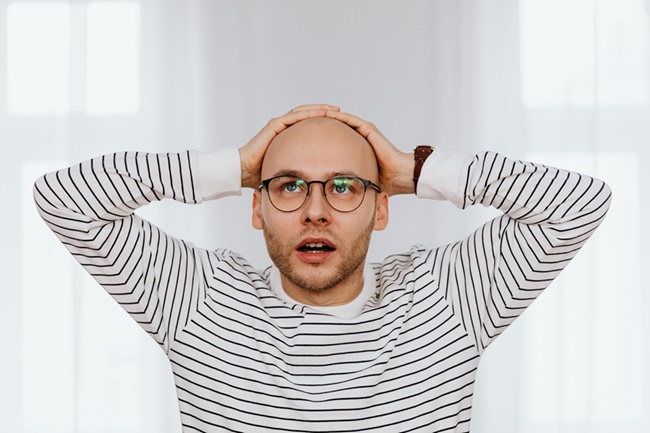Baldness and Dandruff

While baldness and dandruff don’t seem to be tied to one another, they actually are. The question is, can bald people get dandruff? The answer is yes. Bald people also experience dandruff problems despite having no hair to worry about. If you’re asking yourself how, this article is here to explain everything, from the causes and symptoms to management strategies. Please read on to discover more, and thank us later.
What Are the Causes of Dandruff?
Dandruff doesn’t discriminate; it can affect anyone, hairy or not. After all, it is a scalp and not a hair issue. Understanding the causes of this condition can help victims manage it effectively. Here are some of the most common causes you need to understand.
The most common cause of dandruff is Malassezia, a genus of yeasts that feeds on sebum to break it down into byproducts that are seen as dandruff. The yeast often thrives on the scalp, even in the absence of hair.
The second cause of dandruff on both bald and hairy people is an oily scalp. Excess oil on the scalp can mix with dead scalp cells and other debris to clog the hair follicles. When this happens, the normal shedding of skin cells gives rise to dandruff. Excess oil also created a thriving environment for Malassezia (mentioned above).
Dandruff may also be caused by specific skin conditions like contact dermatitis, eczema, hormonal imbalances, and psoriasis, to mention a few. The above factors can lead to dandruff on any part of the body. For instance, psoriasis causes an excess production of cells. When this happens on the scalp, these cells can cause scaly patches that flake off in the form of dandruff.
Another common cause of dandruff is dry skin. When the scalp becomes dry, it also feels itchy and flaky, causing dandruff. This can happen to both bald and hairy individuals.
Lastly, seborrheic dermatitis is yet another cause of dandruff. The skin condition causes itchiness that can lead to skin redness and flakes, making it produce dandruff. Seborrheic dermatitis commonly occurs on the scalp, regardless of whether it is hairy or not.
Symptoms of Dandruff
Dandruff can announce its presence with various distinct signs that are commonly embarrassing. Whether you are bald or have a full head of hair, you need to understand these warning signs so that you can apply the right management strategies.
The most common sign of dandruff is the presence of white flakes on the scalp. The flakes can also be yellowish. Their sizes vary from small and inconspicuous to very large and embarrassing. For bald individuals, the flakes may fall on their shoulders or clothing, creating even more embarrassment.
Another common sign of dandruff is an itchy scalp. This sign can be particularly embarrassing and uncomfortable, too. Unfortunately, the more you scratch your scalp, the more your skin is irritated, causing even more dandruff. Continued scratching may also cause scalp inflammation and redness, leading to more discomfort, especially for bald people.
How To Remove Dandruff from Bald Head
To manage dandruff, we recommend seeing a medical specialist for tailored approach to the condition.
Nevertheless, observing proper scalp hygiene is one of the most effective ways to get rid of dandruff. experts recommend cleaning your scalp with an anti-dandruff shampoo for the best benefits. Following the instructions on the label, apply the shampoo on your scalp and leave it to act for some time before rinsing it all with clean water.
Exfoliation is another excellent option. Use a gentle exfoliating scrub or brush to get rid of the flakes from your scalp. Exfoliation is often touted for its positive benefits on the scalp, including improving its health.
If your dandruff is caused by dryness, we recommend the use of moisturizers for your scalp. This is especially the best option for bald individuals because their head is more likely to experience dryness. Please choose the best moisturizers recommended by other users.
Lastly, we recommend that you avoid hairstyles that use excessive heat to alleviate dandruff caused by a dry scalp. Heat can dry the scalp to cause more flaking and itching. Using cooler dryer settings can significantly reduce the effect of a dry scalp.
Natural Remedies for Dandruff
If you prefer natural remedies for combating dandruff, we have your back. Some of the most effective natural solutions for dandruff include tea tree oil. The oil exhibits anti-fungal properties that can get rid of yeast from the scalp. To effectively apply it, dilute a few tea tree oil drops with a carrier oil. Then, use it to massage your scalp and let it rest there for about 40 minutes before washing it off.
You may also use aloe vera to remove dandruff from your hair. Aloe vera is known for several benefits on the skin, including its soothing effect that can help with an itchy scalp. All you have to do is apply fresh aloe vera gel to your scalp, let it rest for about half an hour, and wash it off.
Conclusion
It is now clear that dandruff and baldness are closer than imagined. Bald individuals can also be victims of dandruff due to causes like underlying skin conditions, oily scalp, and the presence of yeast on the scalp, to mention a few. The condition generally affects the scalp and not the hair. Its symptoms include itching, flakes, and redness, which can cause embarrassment. Nevertheless, it is possible to manage them using the tips recommended above.
